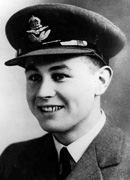
Cyril Joe Barton, VC was a Second World War bomber pilot in the Royal Air Force who received the Victoria Cross, the highest award for gallantry in the face of the enemy that can be awarded to British and Commonwealth Armed Forces.
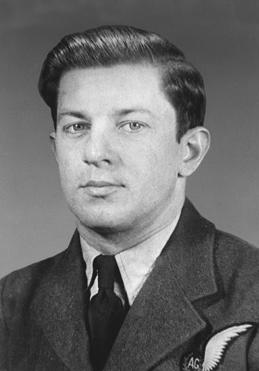
Andrew Charles Mynarski, VC was a Canadian airman and a recipient of the Victoria Cross, the highest award for bravery in the face of the enemy that can be awarded to British and Commonwealth forces. Mynarski was 27 years old and flew with No. 419 "Moose" Squadron, Royal Canadian Air Force during the Second World War when he died attempting to help rescue a trapped crew member. His Victoria Cross, which was awarded in 1946, was the last Victoria Cross received by any Canadian serviceman in the Second World War.
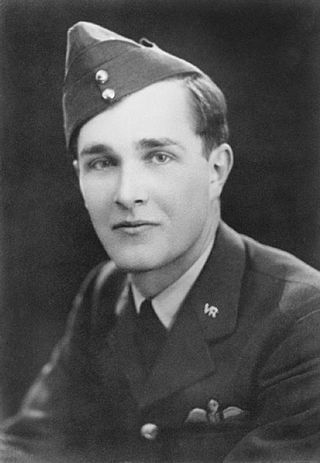
Leslie Thomas Manser, VC was a British bomber pilot and a recipient of the Victoria Cross, which was awarded posthumously following an attack on the German city of Cologne.
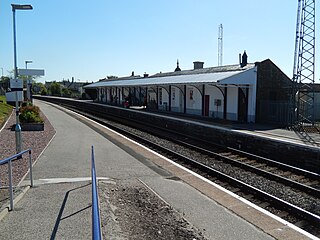
Invergordon railway station is a railway station serving the town of Invergordon on the Cromarty Firth, in the Highland council area of Scotland. It is located on the Far North Line, 31 miles 37 chains (50.6 km) from Inverness, between Alness and Fearn. ScotRail, who manage the station, operate all services.

419 Tactical Fighter Training Squadron was a unit of the Royal Canadian Air Force. The squadron was originally formed during the Second World War and was most recently based at CFB Cold Lake. In its latest incarnation it was responsible for advanced tactical fighter training for pilots of the RCAF and as part of the NATO Flying Training in Canada (NFTC) program using nine CT-155 Hawk trainers.

Cambridge American Cemetery and Memorial is a World War II American military war grave cemetery, lying between the villages of Coton and Madingley, 7 km (4.3 mi) north-west of Cambridge, England. The cemetery, dedicated in 1956, contains 3,811 American war dead and covers 30.5 acres (12.3 ha). It is one of 26 overseas military cemeteries administered by the American Battle Monuments Commission (ABMC).
No. 356 Squadron RAF was a short-lived long-range bomber squadron of the Royal Air Force between 1944 and 1945.
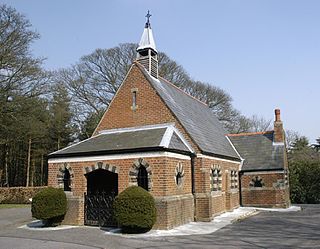
Aldershot Military Cemetery is a burial ground for military personnel, or ex-military personnel and their families, located in Aldershot Military Town, Hampshire.

No. 428 Squadron RCAF, also known as 428 Bomber Squadron, and 428 Ghost Squadron, was first a night bomber squadron of the Royal Canadian Air Force engaged in strategic bombing during World War II, based in Yorkshire. At the end of the war the squadron moved to Nova Scotia before being disbanded in September 1945. In 1954 the squadron was reformed as 428 All-Weather (Fighter) Squadron, before being again disbanded in 1961.
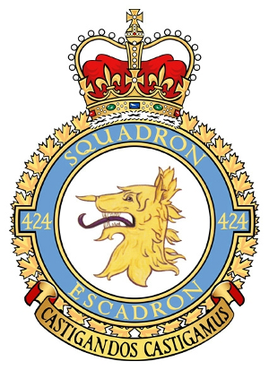
424 Transport and Rescue Squadron, nicknamed "Tiger Squadron", is a Royal Canadian Air Force strategic transport and search and rescue unit based at Canadian Forces Base (CFB) Trenton in the Canadian province of Ontario. The squadron is the primary provider of search and rescue response for the Trenton Search and Rescue Region, which extends from Quebec City to the Rocky Mountains, and from the Canada–United States border to the North Pole, covering an area of over ten million square kilometres in Central, Western, and Northern Canada.

Hamilton Road Cemetery is a combined municipal and military burial ground situated in the coastal town of Deal, Kent, in South East England. Opened in May 1856, it was created to provide a new burial ground for Deal at a time when its general population was expanding and when previous, often ad hoc facilities for dealing with deaths in the area no longer sufficed.

Frank Donald Collinge was a Canadian fencer. He competed in five events at the 1936 Summer Olympics. He was killed in action during the Second World War.

Frank Vernon Watkins was an officer of the Royal New Zealand Air Force (RNZAF) during the Second World War. He was killed in air operations trying to save a close comrade and for this action was recommended for the Victoria Cross, the highest award for gallantry in the face of the enemy that can be awarded to British and Commonwealth forces.

Royal Air Force Ossington or more simply RAF Ossington is a former Royal Air Force station located near the village of Ossington, Nottinghamshire, England.

The 1943 Saint-Donat Liberator III Crash was an aerial accident that killed 24 people—the worst accident in Canadian military aviation history.

Gilbert William Walenn, known as Tim Walenn, was a British bomber pilot who was taken prisoner during the Second World War. He took part in the "Great Escape" from Stalag Luft III in March 1944, but was re-captured and subsequently shot by the Gestapo.

Gordon Arthur Kidder, was a Royal Canadian Air Force officer, the navigator of a Vickers Wellington bomber, who was taken prisoner during the Second World War. He took part in the 'Great Escape' from Stalag Luft III in March 1944, but was one of the men recaptured and subsequently shot by the Gestapo.

The aircrews of RAF Bomber Command during World War II operated a fleet of bomber aircraft carried strategic bombing operations from September 1939 to May 1945, on behalf of the Allied powers. The crews were men from the United Kingdom, other Commonwealth countries, and occupied Europe, especially Poland, France, Czechoslovakia and Norway, as well as other foreign volunteers. While the majority of Bomber Command personnel were members of the RAF, many belonged to other air forces – especially the Royal Canadian Air Force (RCAF), Royal Australian Air Force (RAAF) and Royal New Zealand Air Force (RNZAF). Under Article XV of the 1939 Air Training Agreement, squadrons belonging officially to the RCAF, RAAF, and RNZAF were formed, equipped and financed by the RAF, for service in Europe. While it was intended that RCAF, RAAF, and RNZAF personnel would serve only with their respective "Article XV squadrons", in practice many were posted to units of the RAF or other air forces. Likewise many RAF personnel served in Article XV squadrons.

Royal Canadian Air Force Station Dunnville was a Second World War British Commonwealth Air Training Plan (BCATP) station located near Dunnville, Ontario. The station was home to No. 6 Service Flying Training School and is usually known by that name. Service Flying Training schools trained pilots, either single engine or multi-engine, and 6 SFTS was a single engine school. After graduation the new pilots were assigned various duties, which might be overseas in the Royal Air Force or an RCAF squadron; or in Canada as instructors or staff pilots in the BCATP, or for duty in RCAF Home Defence squadrons.
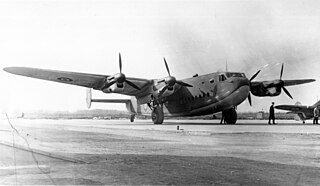
On 1 February 1945 an Avro York carrying members of the British delegation to the Yalta conference crashed off the Italian island of Lampedusa. During the flight to Yalta, undertaken during night time, the crew became unsure of their position due to a navigation radio malfunction. The aircraft ended up over Lampedusa and circled for approximately one hour as crew members attempted to verify their position. The crew eventually determined the proper course to Malta but by then the aircraft lacked the fuel quantity to cover the distance. During an attempted ditching the Avro crashed into the sea, killing all four crew and 11 passengers. Some sources state there were four survivors.





















